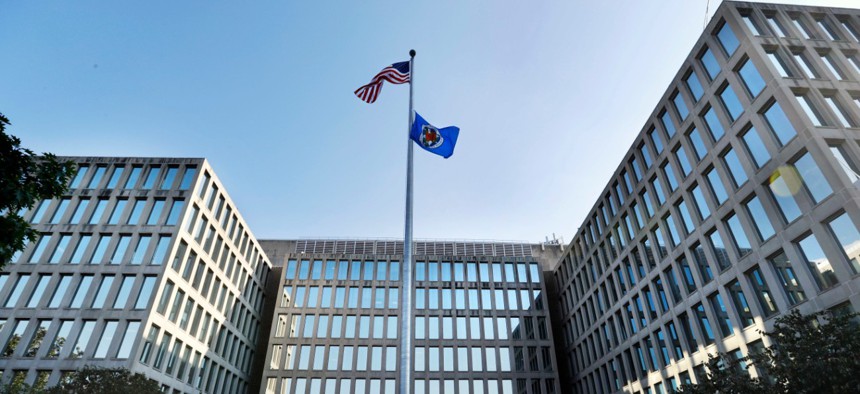
OPM headquarters. Jacquelyn Martin/AP
OPM Delays Annual Workforce Survey Again Four Days Before Kickoff
The federal government’s human resources agency declined to explain the reasoning for the last minute postponement aside from allowing agencies to “focus on critical missions.”
The Office of Personnel Management announced Thursday that it would postpone administration of its annual survey of federal employee engagement and morale until September, just four days before it was set to roll out to workers and all but guaranteeing results would not be posted on time this year.
Two weeks ago, OPM said that following a two-month delay due to the coronavirus pandemic, federal employees would be invited to participate in the survey beginning July 13. As part of that announcement, Acting Director Michael Rigas urged agency heads to encourage employees to participate and highlight how agencies use survey data to improve workforce policies.
But on Thursday, Rigas reversed course, pushing the survey back for at least another two months and providing little additional information. When OPM does administer the survey, it will be open for one six-week period for all of the federal government, rather than splitting it into two six-week waves.
“The U.S. Office of Personnel Management’s 2020 Federal Employee Viewpoint Survey is being postponed to support your critical agency missions as well as maximize employee participation in the survey,” Rigas wrote in a memo to agency heads. “The governmentwide FEVS administration is being postponed from Monday, July 13 to Monday, September 14, with a six-week fielding period for each agency . . . We apologize for the late notification and appreciate the efforts you and your staff have undertaken to prepare for the 2020 FEVS.”
An OPM spokesperson who declined to be named would only say the survey was delayed “so that agencies can focus on critical missions for the American people.”
Partnership for Public Service President Max Stier, whose organization uses the survey’s results to compile the annual Best Places to Work in the Federal Government report, said the delay came as a surprise.
“We had not heard any further information about a delay beyond the move to July,” Stier said. “The last understanding we had was that this would go forward in July. So we’ve heard that it was moved, but without any rationale aside from the government being busy with the response to the coronavirus. I would say it’s unfortunate that it’s being pushed back again.”
Stier said he disagrees with the idea that agencies and federal workers are too busy to fill out the survey, and he argued that agency leaders and managers need timely employee engagement data now more than ever.
“The survey isn’t a ‘nice to have,’ it’s critical information for managers to understand what’s going on with their workforce,” he said. “It’s even more important now than it normally is. The government is demonstrably doing more urgent work, and so having that data to be able to appreciate where there are problems and where things are working well is fundamental to good management . . . I think the amount of time it requires for individual employees to take the survey is quite small, and if anything, if leadership listens to the results then employees are more than willing to give that extra energy for that benefit.”
Stier applauded OPM’s decision to ask a series of questions related to the federal government’s coronavirus response but said it’s important that agencies receive that information now, rather than at some point after the pandemic has begun to subside.
“It takes a long time for the information to be gathered, to be put together by OPM and its contractor and then go to agencies and the public,” Stier said. “The delay matters because [the data release] is not going to happen for some significant period of time even after it’s collected. It means once more that leadership across the government is flying blind with regard to its employees and that’s not a good thing.”







